Flies: The Uninvited Buzzing Nuisance!
Nothing ruins a peaceful day faster than the annoying buzz of a fly darting around your kitchen, landing on your food, and refusing to leave! These winged intruders are more than just a nuisance—they can spread bacteria, contaminate surfaces, and multiply rapidly if not controlled. Whether it’s house flies, fruit flies, drain flies, or cluster flies, these pesky invaders always seem to find a way inside. But don’t worry—we have the tools and expertise to send them packing!
Say goodbye to the swatting and frustration—contact our amazing team today and let’s reclaim your space from these flying pests!
Fly Control & Prevention
Flies may play a role in nature, but that doesn’t mean you want them buzzing around your home or business. Whether it’s house flies contaminating food, fruit flies breeding in your kitchen, or drain flies emerging from your sink, these pests can quickly become a frustrating and unsanitary nuisance. Some species also spread bacteria, making them a health risk in both residential and commercial settings.
Our fly control services target both existing infestations and the conditions that attract them, keeping your property comfortable and fly-free year-round.
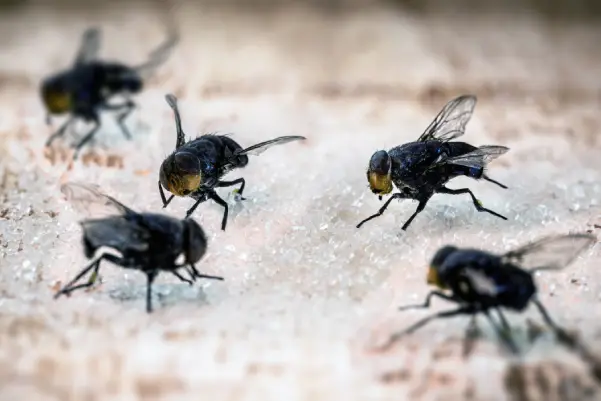 Comprehensive Fly Inspection
Comprehensive Fly Inspection
Before implementing treatment, our experts perform a detailed inspection to:
- Identify fly species present in and around your property
- Locate breeding and harborage areas, such as drains, garbage bins, organic debris, and food sources
- Assess contributing factors that may be attracting flies, such as moisture, exposed food, and sanitation issues
- By understanding the root cause of your fly problem, we create a customized treatment plan for maximum effectiveness
Effective Fly Control Treatments
Our multi-step approach is designed to eliminate active fly populations and prevent future infestations:
- Targeted Fly Treatments
- Drain & Moisture Control
- Insect Light Traps & Monitoring
Ongoing Prevention & Monitoring
- Since flies thrive in areas with accessible food, moisture, and organic debris, sanitation and exclusion are key for long-term fly prevention. Our recurring pest control services help reduce fly populations and keep your property protected.
Long-Term Fly Prevention Strategies
- Eliminate food and waste sources – Keep trash bins sealed, clean up food spills, and store food properly
- Regular drain maintenance – Prevent buildup that attracts drain flies and fungus gnats
- Fix moisture issues – Address leaks, standing water, and damp areas where flies can breed
- Seal entry points – Repair cracks, install window screens, and use door sweeps to keep flies out
Our comprehensive fly control program provides immediate relief from active infestations while ensuring your home or business stays fly-free and sanitary all year long.
Flies: More Than Just an Annoying Buzz!
Flies are one of the most frustrating pests to deal with—they invade homes and businesses, contaminate food, and reproduce rapidly. Some flies are just a nuisance, while others can carry bacteria and spread diseases. Whether you are dealing with common house flies, fruit flies, drain flies, or cluster flies, these pests seem to appear out of nowhere and never leave!
But not to worry—we have the solutions to keep them out for good! Our professional fly control services target the source of the infestation, using expert techniques to eliminate active fly populations and prevent future invasions.
- Quarterly & Bi-Monthly Programs
- Target Pests: Ants, spiders and various other crawling insects
-
Service Includes:
- Exterior perimeter inspection and application for crawling insect control
- Removal of accessible wasp nests on the structure of your home
- Sweeping of spider webs followed by an overhead application for spider control
- Interior services as needed
- Quarterly & Bi-Monthly Programs
- Target Pests: Rats, mice, ants, spiders and various other crawling insects.
-
Service Includes:
- Exterior perimeter inspection and application for crawling insect control
- Removal of accessible wasp nests on the structure of your home
- Sweeping of spider webs followed by an overhead application for spider control
- Service exterior rodent bait stations and inspect for potential entry points
- Interior services as needed
- Quarterly & Bi-Monthly Programs.
- Target Pests: Rats & Mice.
-
Service Includes:
- Exterior perimeter inspection for potential entry points, nesting areas or food sources.
- Seal up identified entry points to prevent the rodents from accesses the interior of your home.
- Service exterior and interior rodent bait stations.
- Interior services as needed.
Identification
Common Large Fly Species & How to Identify Them
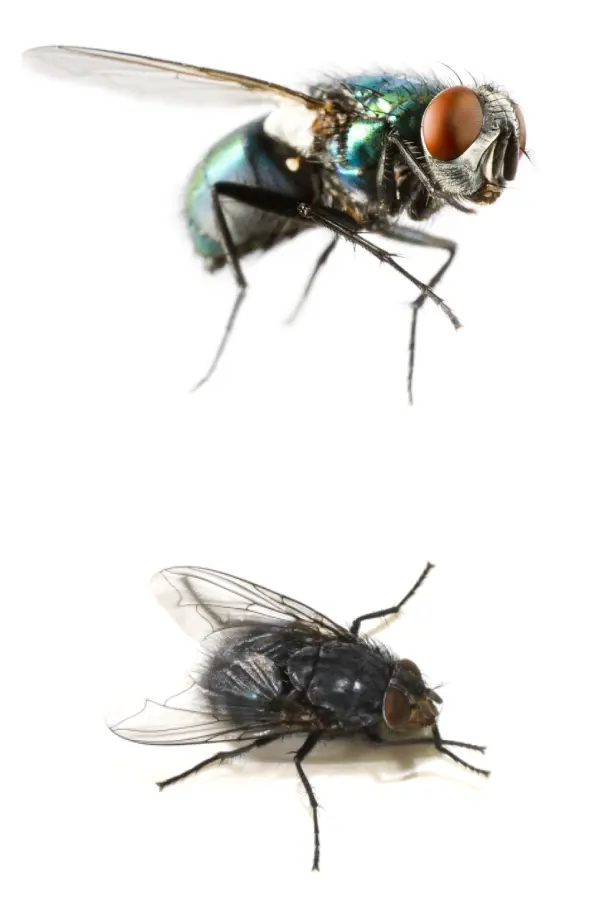 House Fly
House Fly
- Size: About ¼ inch long
- Color: Gray body with four dark stripes on the thorax
- Behavior: Fast fliers, attracted to food, garbage, and decaying matter
- Where Found: Kitchens, trash bins, countertops, windows
Why They Are a Problem: House flies spread bacteria like E. coli and Salmonella by landing on food, surfaces, and waste.
Cluster Fly
- Size: ⅜ inch long, slightly larger than a house fly
- Color: Dark gray body with golden hairs on the thorax
- Behavior: Slow-moving, clumsy fliers that gather in large groups inside homes
- Where Found: Walls, attics, window sills, crawl spaces (especially in fall/winter)
Why They Are a Problem: Cluster flies invade homes in the fall to overwinter, gathering in large numbers inside walls and attics.
Blow Fly
- Size: About ⅜ inch long, larger than house flies
- Color: Metallic blue, green, or bronze body
- Behavior: Buzz loudly and are strong fliers
- Where Found: Garbage bins, dead animals, pet waste, decaying organic matter
Why They’re a Problem: Blow flies breed in decaying matter and are a sign of dead rodents, animals, or waste buildup nearby and they can spread bacteria from rotting food and carcasses to household surfaces.
Common Large Fly Species & How to Identify Them
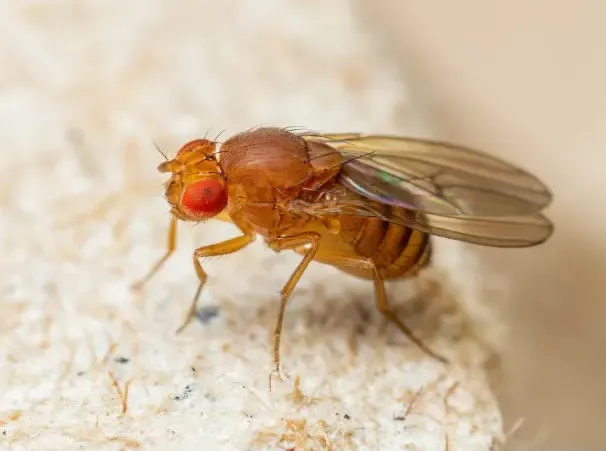 Fruit Fly
Fruit Fly
- Size: Tiny, about ⅛ inch long
- Color: Light tan or brown with bright red eyes
- Behavior: Weak fliers, hover around overripe fruit, sugary liquids, and drains
- Where Found: Kitchens, pantries, bars, near sinks and garbage disposals
Why They’re a Problem: Fruit flies breed in fermenting food and can lay 500 eggs at a time, making them hard to eliminate. They are attracted to ripened produce, juice spills, and even dirty dish sponges.
Fungus Gnat
- Size: Tiny, about ⅛ inch long
- Color: Dark gray or black with long legs and antennae
- Behavior: Weak, erratic fliers, often seen near houseplants and damp soil
- Where Found: Indoor potted plants, overwatered soil, damp basements
Why They’re a Problem: Fungus gnats lay eggs in moist soil and can damage plant roots, overwatering houseplants encourages infestations.
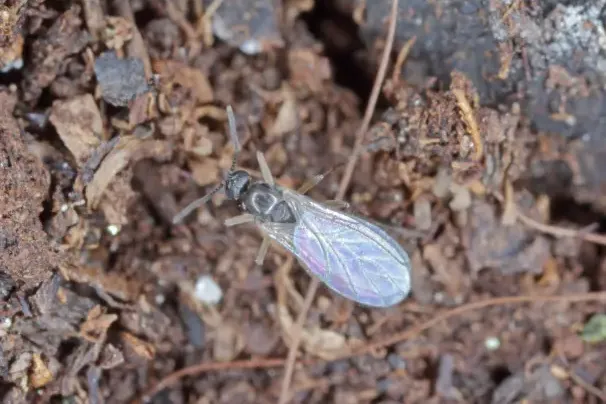 Drain Fly
Drain Fly
- Size: Tiny, about ⅛ inch long
- Color: Fuzzy, moth-like appearance with tan or gray wings
- Behavior: Weak fliers, prefer to crawl along walls and surfaces near drains
- Where Found: Sinks, shower drains, floor drains, and standing water
Why They’re a Problem: Drain flies breed in the organic slime that builds up inside pipes and drains. While they do not bite, large infestations are tough to eliminate without deep drain cleaning.
Effective Fly Control Treatments
Our multi-step approach is designed to eliminate active fly populations and prevent future infestations:
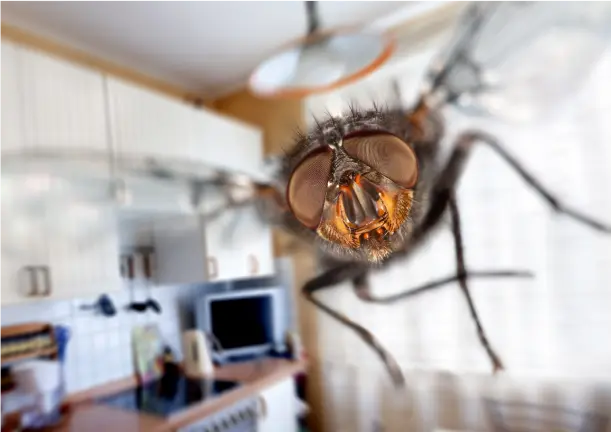 Targeted Fly Treatments
Targeted Fly Treatments
- Residual insecticide applications in key areas where flies rest and breed, such as walls, windows, and entry points
- Crack and crevise applications
- Baiting strategies for high-fly-activity areas, including outdoor spaces and food prep areas
- Aerosol treatments in severe infestations to reduce adult fly populations quickly
Drain & Moisture Control
- Enzyme-based drain treatments to break down organic buildup and eliminate drain fly breeding grounds
- Moisture management solutions, including recommendations for fixing leaks and reducing standing water
Fly Traps & Monitoring
- Pheromone and light traps to catch flies and monitor activity levels
- Strategic placement of traps to prevent flies from breeding and spreading indoors
Our Outside-In Approach to Large Fly Control
Effectively managing large fly populations requires a proactive strategy that stops flies before they invade indoor spaces. Our Outside-In Approach focuses on identifying the root cause of fly activity and addressing issues at multiple levels before flies reach the interior. This approach works best with a strong partnership between us and our customers, ensuring that sanitation, exclusion, and targeted treatments are implemented effectively.We focus on three key areas, working from the outside in:
PREVENT entry opportunities. Open doors are the primary route for large flies to gain access to the inside. Finding ways to minimize open-door time is essential, but often there is no other choice. In areas where there is high exterior pressure and doors are opened repeatedly, other options such as vestibules, air curtains, plastic strips, etc. should be recommended to the customer. REDUCE fly pressure on the exterior. Good sanitation on the exterior is the key to reducing fly pressure. Targeted treatment of exterior surfaces and use of Fly Bait Stations in areas where large flies congregate (such as the dumpster corrals and garbage areas) will help reduce the number of flies near entrances, reducing large fly pressure. ELIMINATE activity on the interior. If large flies are gaining access to the interior, the best options are to look for better ways to ‘reduce pressure on the exterior’ and ‘minimize entry opportunities.’ Killing flies inside is the least effective way to address a large fly issue.The Best Fly Control is Proactive, Not Reactive!
Large fly infestations don’t start indoors—they start outside. With our Outside-In Approach, we work with our customers to prevent, reduce, and eliminate fly activity before it becomes a major issue. So if you are struggling with large flies? Let’s stop them at the source—contact us today!Fly Prevention Tips
Keeping flies out requires proper sanitation, food storage, and moisture control.
Follow these tips to reduce the chances of an infestation:
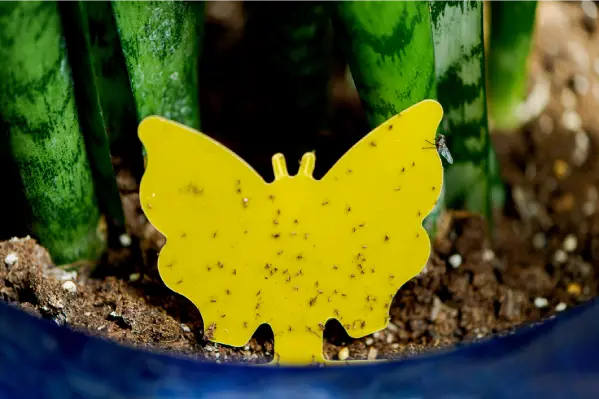 Eliminate Food Sources – Keep food covered, clean up crumbs, and store produce in the fridge
Eliminate Food Sources – Keep food covered, clean up crumbs, and store produce in the fridge- Empty Trash Regularly – Dispose of garbage frequently and use sealed trash cans
- Clean Drains & Sinks – Use enzyme cleaners to remove organic buildup in pipes
- Keep Windows & Doors Sealed – Install screens and repair cracks or gaps where flies can enter
- Reduce Moisture – Fix leaky faucets, standing water, and damp soil in houseplants
- Maintain Your Yard – Remove pet waste, overripe fruit, and compost piles to avoid attracting flies
The Best Fly Control is Proactive, Not Reactive!
Large fly infestations don’t start indoors—they start outside. With our Outside-In Approach, we work with our customers to prevent, reduce, and eliminate fly activity before it becomes a major issue.
Struggling with flies? Let’s stop them at the source—contact us today!

